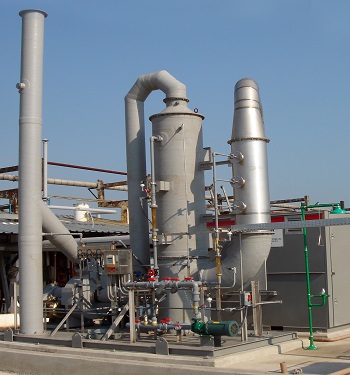Understanding Oxidizers:
A Comprehensive Guide to Industrial Air Pollution Control
July 2024
This guide will explore the workings, types, applications, and considerations of oxidizers in industrial settings.
Air pollution control is a vital concern for many industrial facilities, globally. Processes that produce odours, volatile organic compounds (VOCs), or hazardous air pollutants (HAPs) must adhere to stringent emission regulations to protect the environment. Oxidizers, including thermal and catalytic types, play a crucial role in this process.
This guide will explore the workings, types, applications, and considerations of oxidizers in industrial settings. However, as many industrial processes and settings are unique, this guide provides an overview and more specific solutions can be explored with our expert team.
What are oxidizers?
Oxidizers are devices used to control air pollution by breaking down hazardous gases from industrial exhaust streams into less harmful substances. This is achieved through combustion, which transforms pollutants into carbon dioxide (CO2), water (H2O), and heat. The main types of oxidizers are thermal oxidizers and catalytic oxidizers.

Thermal oxidizers
Thermal oxidizers are integrated into industrial ventilation systems to process pollutants before they are released into our atmosphere. They heat fumes to approximately 1500 °F (815 °C), causing hydrocarbon-based pollutants to undergo oxidation, which converts hazardous gases into heat, water, and carbon dioxide. These less harmful vapours are then cooled and emitted, replacing the original HAPs and VOCs.
Types of Thermal Oxidizers
- Direct Fired Thermal Oxidizers (DFTO):
- Also known as fume incinerators, enclosed flares, or afterburners.
- Simple, cost-effective units comprising a burner and a combustion chamber.
- Achieve a destruction rate exceeding 99.9% efficiency.
- Recuperative Thermal Oxidizers:
- Incorporate heat exchangers to decrease fuel requirements.
- Pollutant-laden air passes through the heat exchanger, preheating the airstream.
- Efficient with low operating costs, achieving destruction rates over 99.9%.
- Regenerative Thermal Oxidizers (RTO):
- The most energy-efficient oxidizers, using ceramic heat exchange media.
- Recover up to 97% of thermal energy generated in processing.
- Significantly reduce operating costs and fuel consumption.
- Regenerative Catalytic Oxidizers (RCO):
- Similar to RTOs but with an added catalyst in the ceramic medium.
- Allow combustion at lower temperatures, further reducing energy and fuel requirements.
- Rotary Concentrators:
- Specialized systems processing large quantities of polluted air with low pollutant concentrations.
- Use zeolite rotors to continuously strip and adsorb VOCs.
- Extremely cost-effective, with the oxidizer consuming nearly zero fuel in many cases.
How do Thermal Oxidizers work?
The process involves directing the emissions stream into the oxidizer in either a forced draft or induced configuration. Ambient air may be added if the ventilated stream does not contain enough oxygen for combustion.
Preheating:
Emissions in nonrecuperative oxidizers do not undergo preheating before combustion.
Recuperative oxidizers use a heat exchanger to preheat the air, increasing fuel efficiency and decreasing operating costs.
Combustion:
Air is heated between 1400 °F to 1600 °F (760 °C to 871°C) in the combustion chamber.
Necessary to ensure complete breakdown of VOCs and HAPs into heat, water, and carbon dioxide.
Destruction requires a dwell time of 0.5 to 1.0 seconds.
Post-Processing:
Treated air moves through the hot pass of the heat exchanger and is cooled before release in systems with a heat exchanger.
Nonrecuperative systems exhaust the processed steam directly into the atmosphere.
Catalytic Oxidizers
Catalytic oxidizers operate similarly to thermal oxidizers but use a catalyst to lower the oxidation temperature, which reduces fuel consumption and operating costs. They can achieve up to 99.9% removal efficiency of pollutants.
Applications of Oxidizers
Thermal and catalytic oxidizers are used across numerous industries to manage air quality and ensure regulatory compliance. Common applications include:
- Automotive Manufacturing
- Chemical Processing
- Coating & Converting
- Composites & Carbon Fiber
- Electronics & Semiconductors
- Energy & Heat Recovery
- Food & Beverage Processing
- Metal Coating
- Mining
- Natural Gas
- Painting & Spraying
- Pharmaceutical & Medical Devices
- Printing & Packaging
- Refining & Petrochemical
- Soil & Groundwater Remediation
- Renewable Energy
- Rubber Curing
Considering when selecting an oxidizer
As pioneers in sustainable energy solutions, we remain committed to pushing the boundaries of innovation and driving positive change in the industry. Building on the success of this project, we are excited to continue exploring new opportunities to revolutionise energy systems, create value for our clients, and build a more sustainable future for generations to come.
At the core of our success lies a dedicated team of experts, passionate about harnessing technology to address the most pressing challenges of our time. Together, we are not only transforming the way we produce and consume energy but also inspiring others to join us on this journey towards a brighter, greener tomorrow.
Investing in a thermal or catalytic oxidizer requires evaluating several factors:
- Type of Oxidizer:
- Determine whether a thermal or catalytic oxidizer is necessary for the application.
- Heat Exchanger:
- Consider the durability and efficiency of shell and tube heat exchangers versus plate heat exchangers.
- Airflow Analysis:
- Analyse upstream processes to ensure unnecessary sources are not treated, reducing capital and operating costs.
- Particulate Matter:
- Assess the size and quantity of particulates to influence tube size requirements.
- Local Regulations:
- Ensure compliance with evolving emissions standards, such as low NOx burners.
- Secondary Heat Exchange:
- Evaluate if secondary heat recovery is beneficial for the facility.
Conclusion
Oxidizers, both thermal and catalytic, are essential for managing air pollution in industrial settings. By understanding their functions, types, and applications, industries can make informed decisions to ensure compliance and support a sustainable future.
Together, we can create a healthier, more sustainable future.

